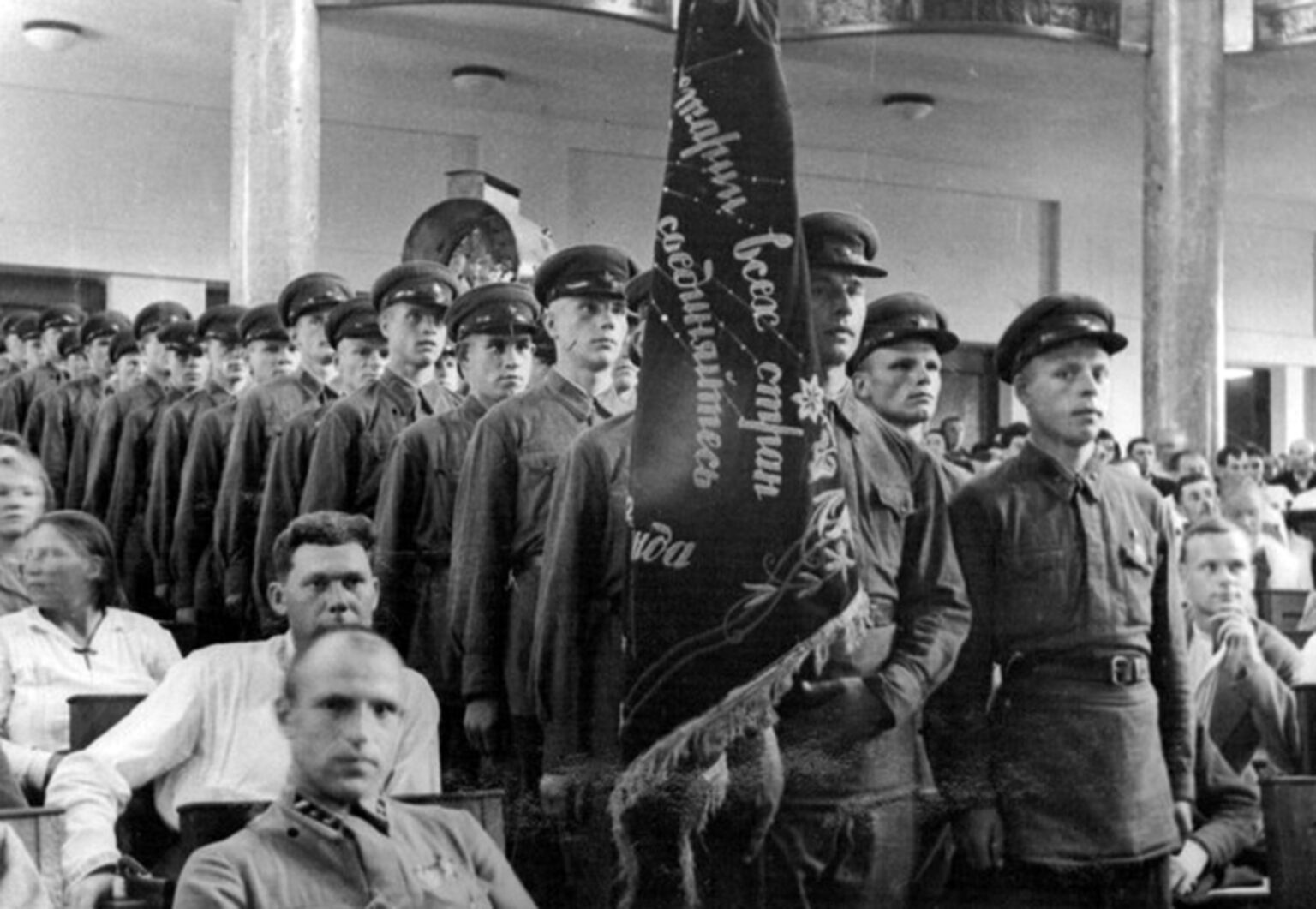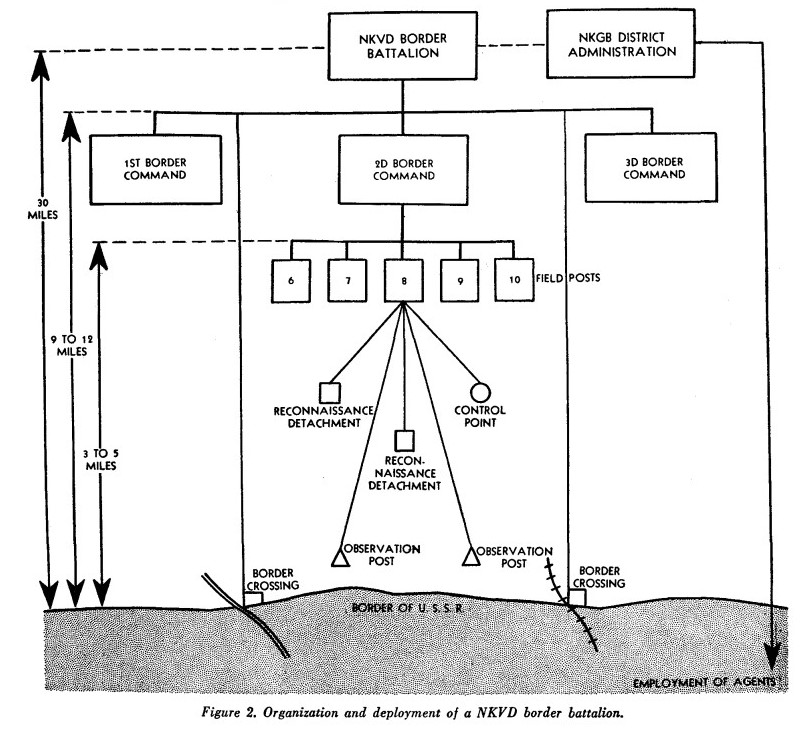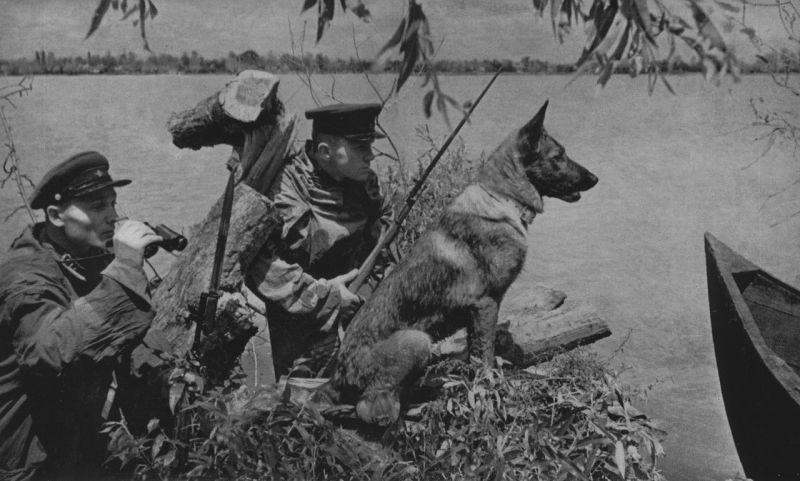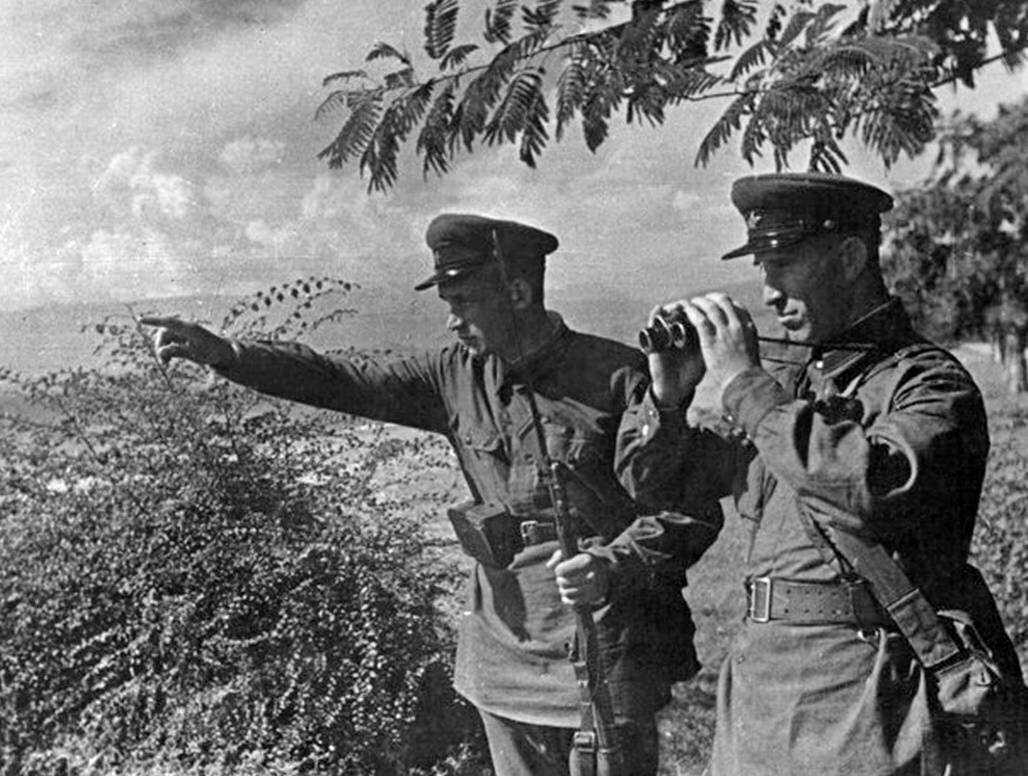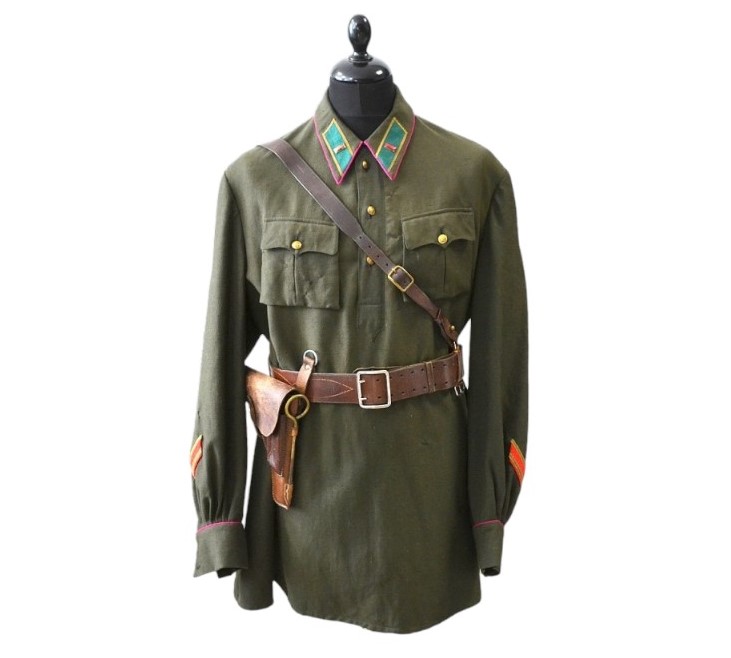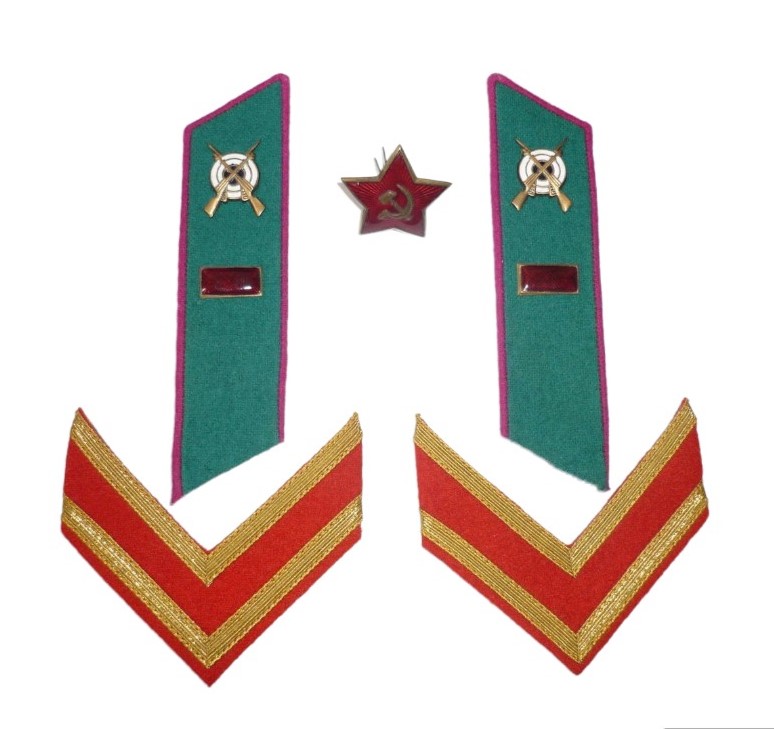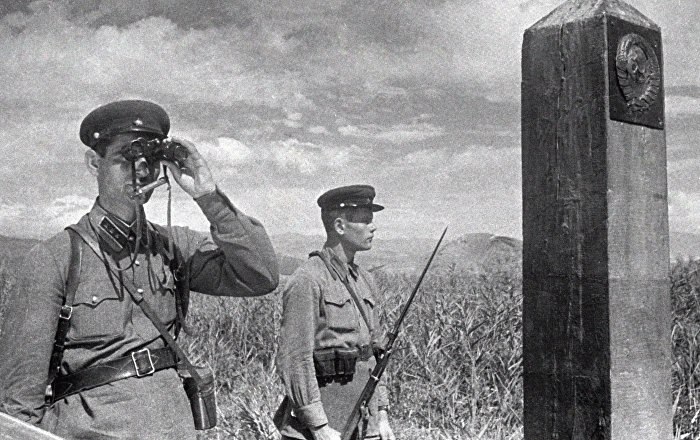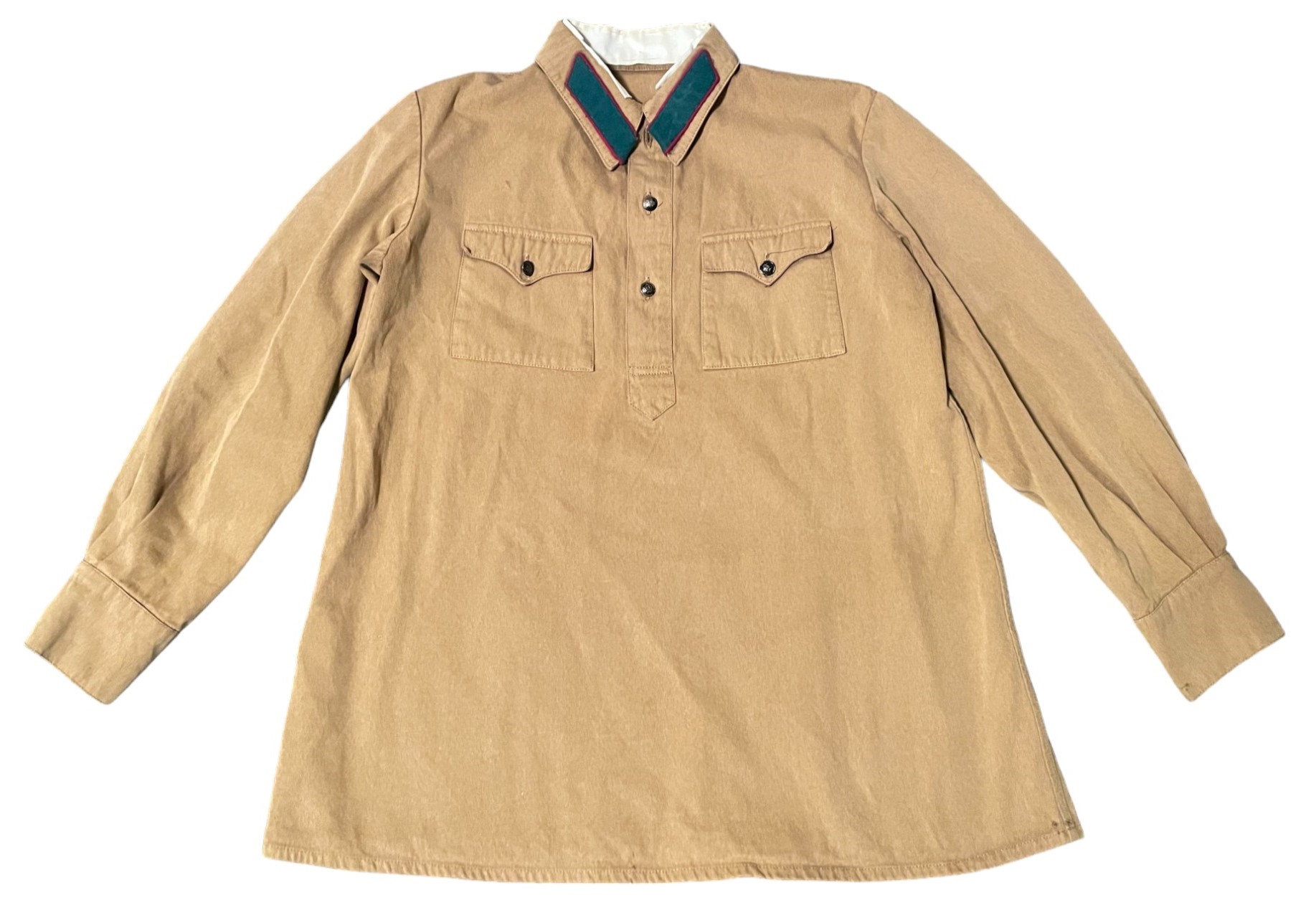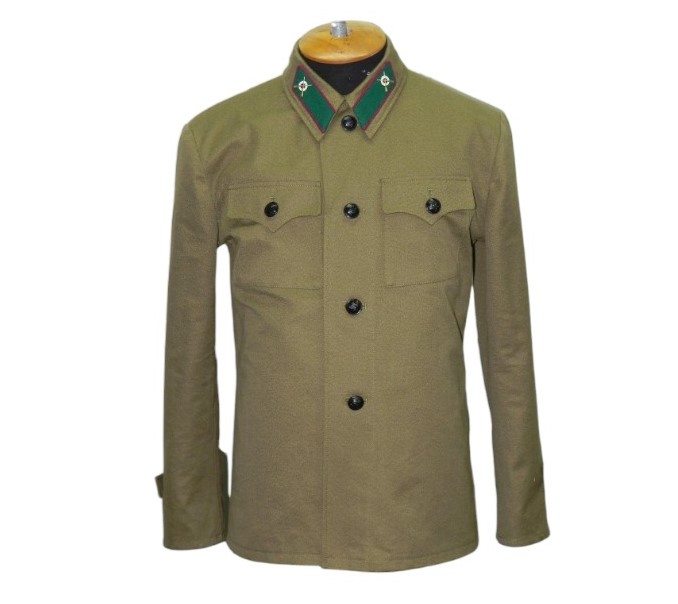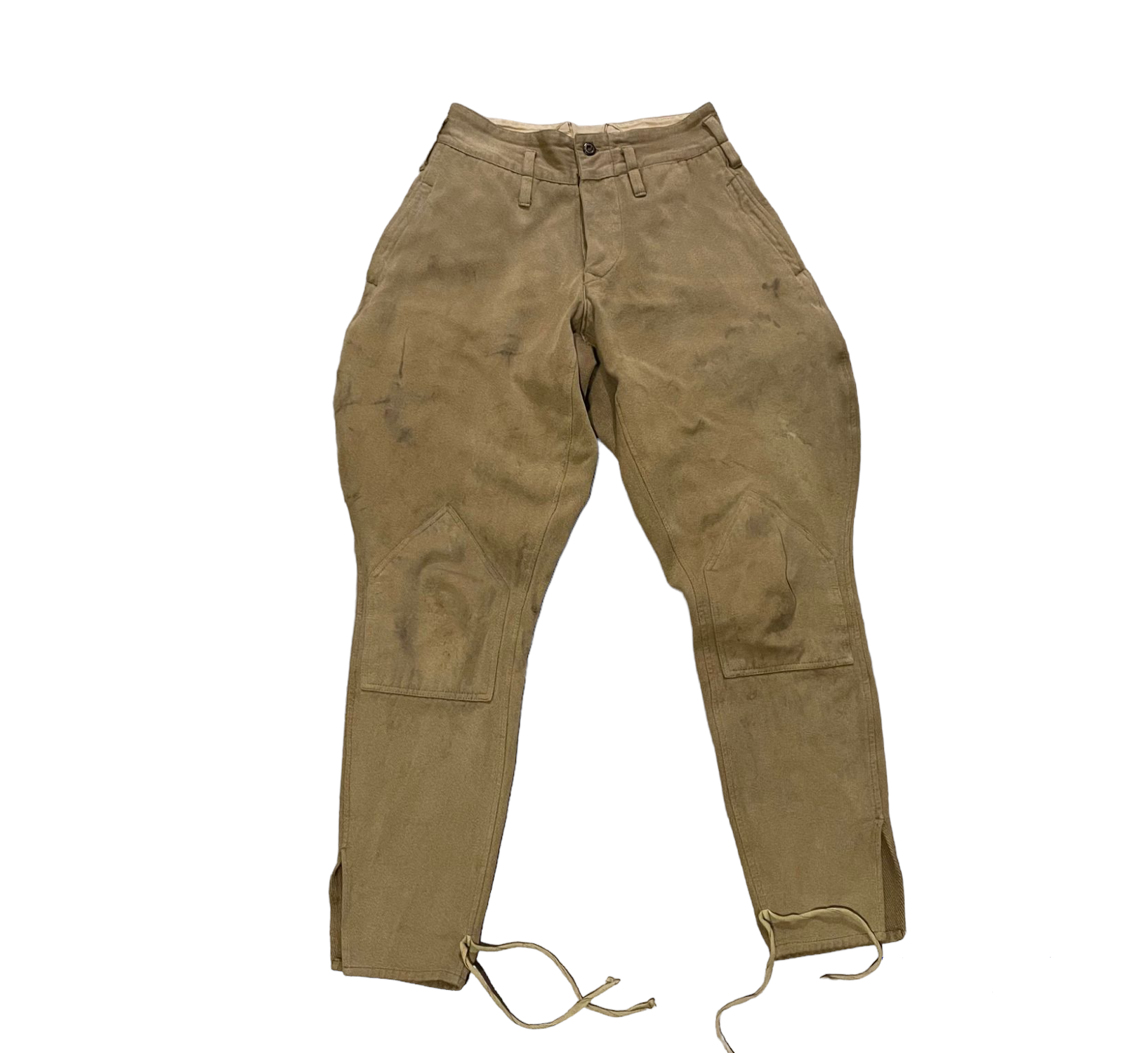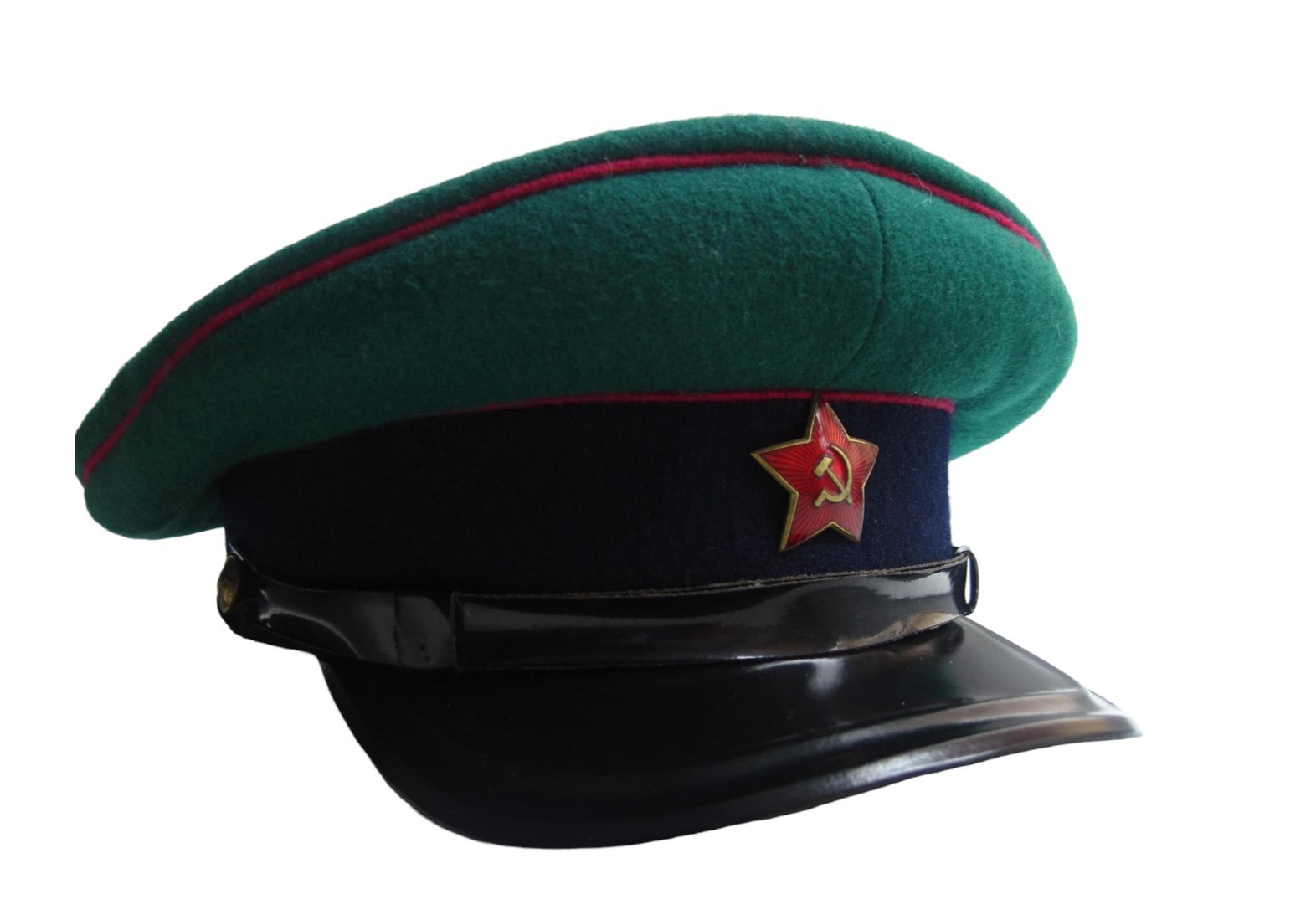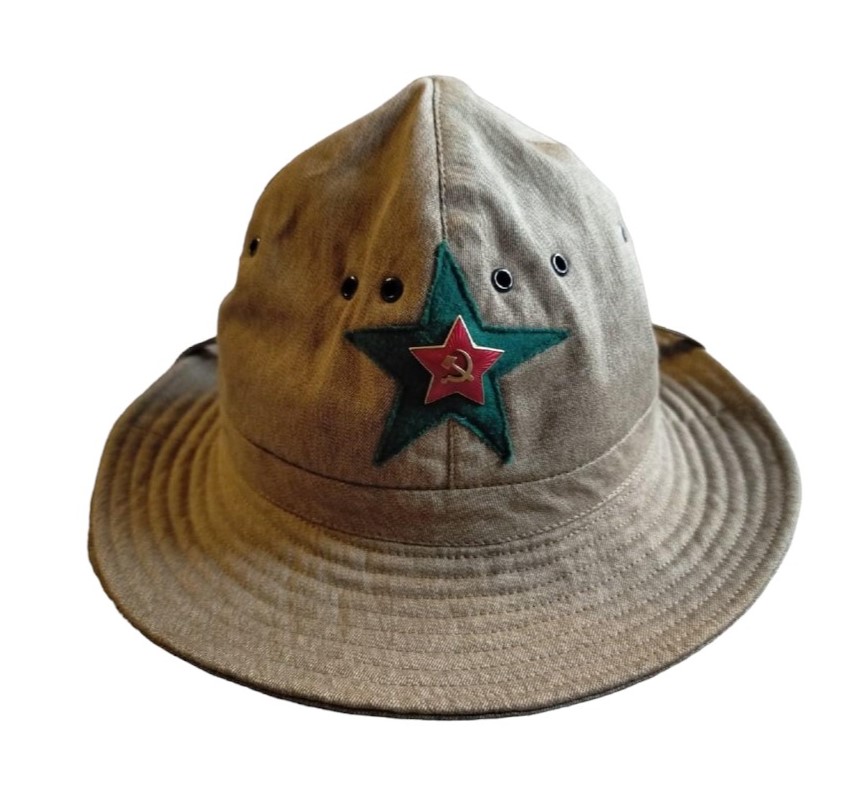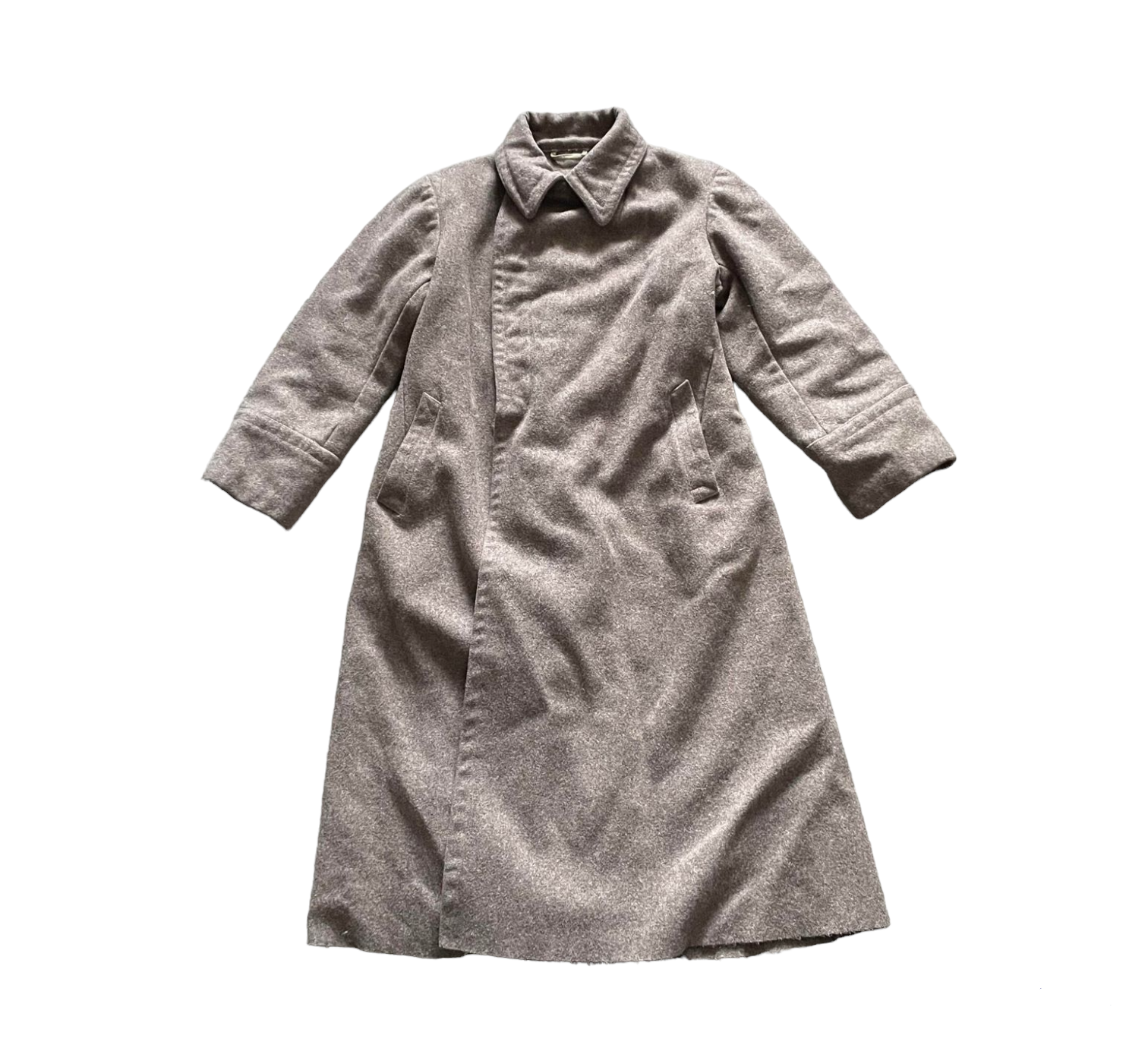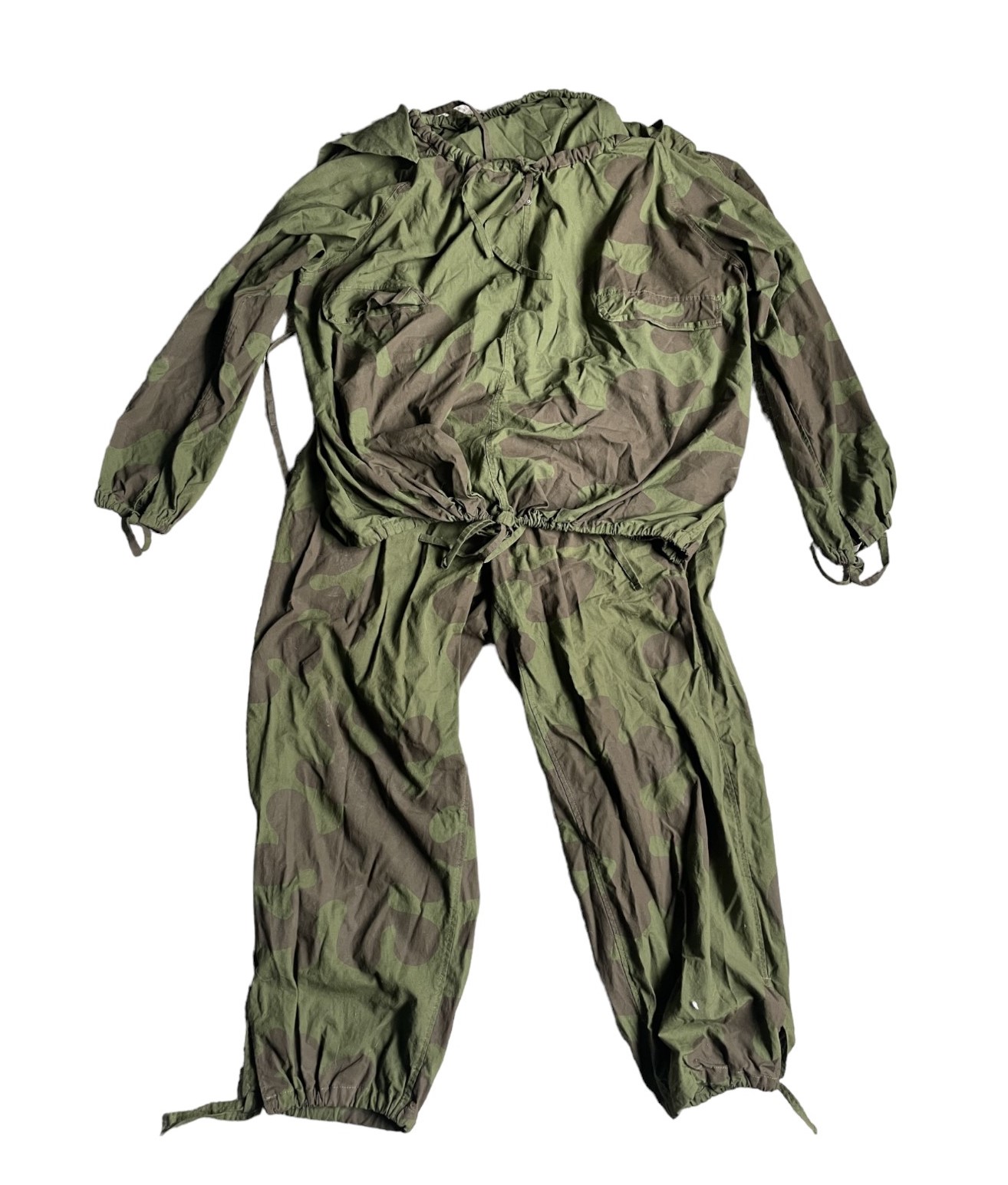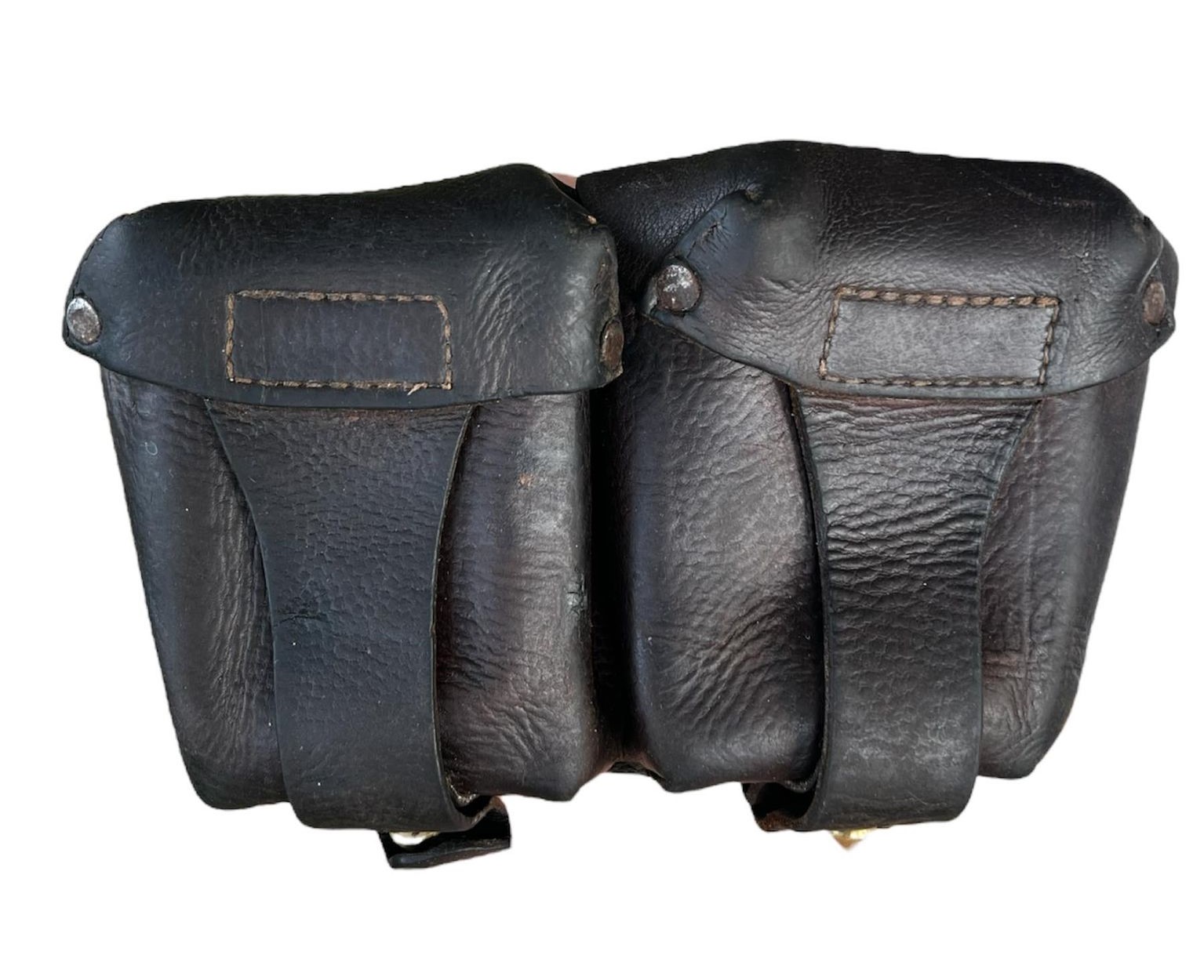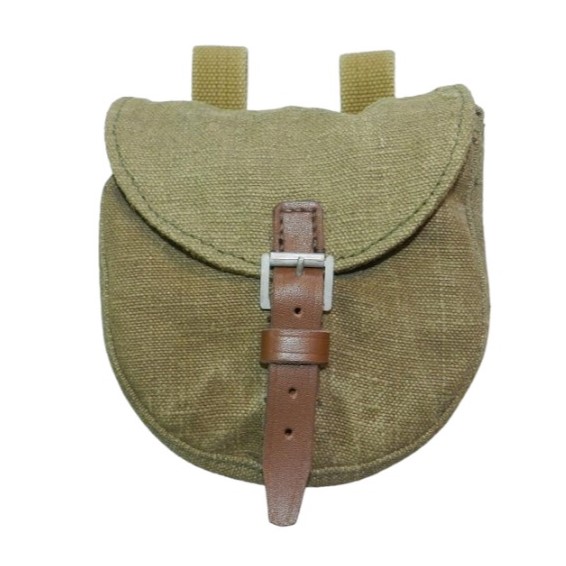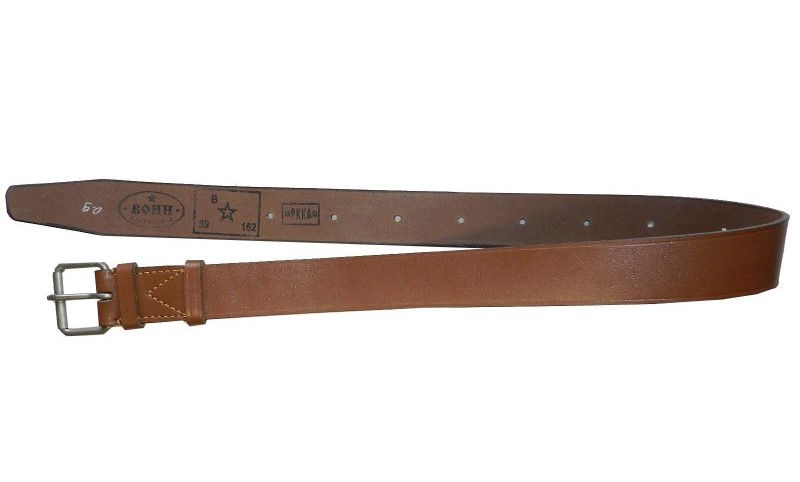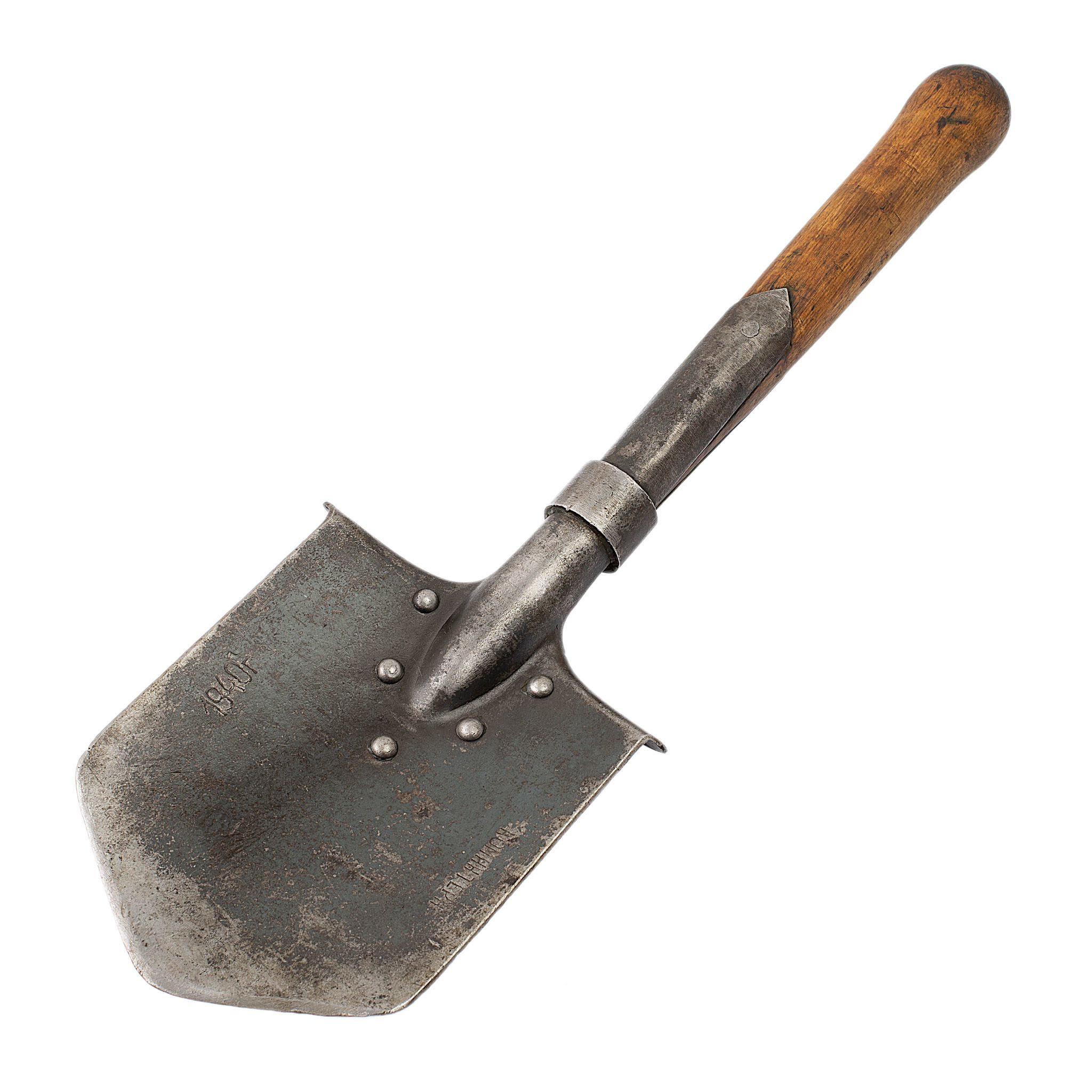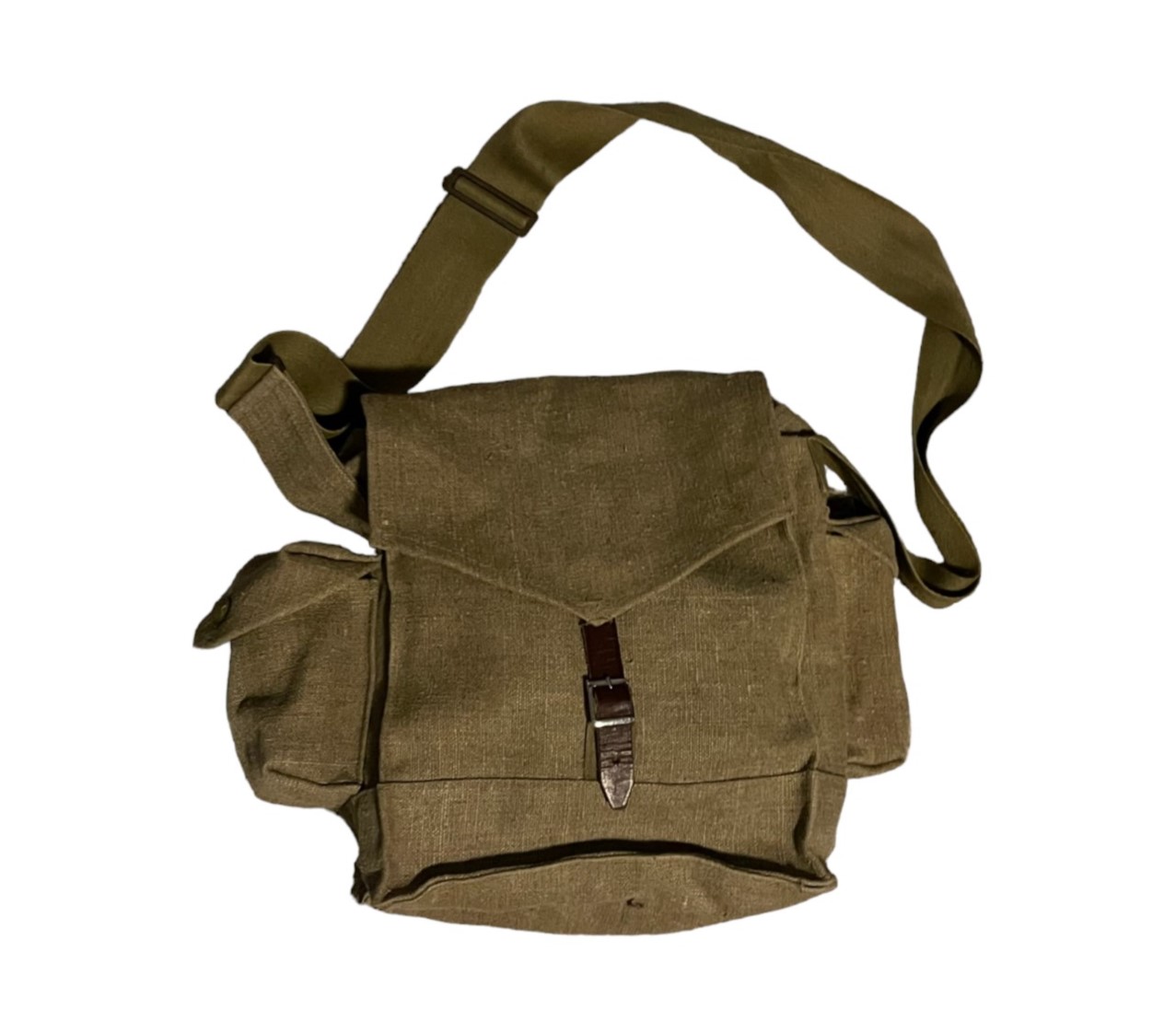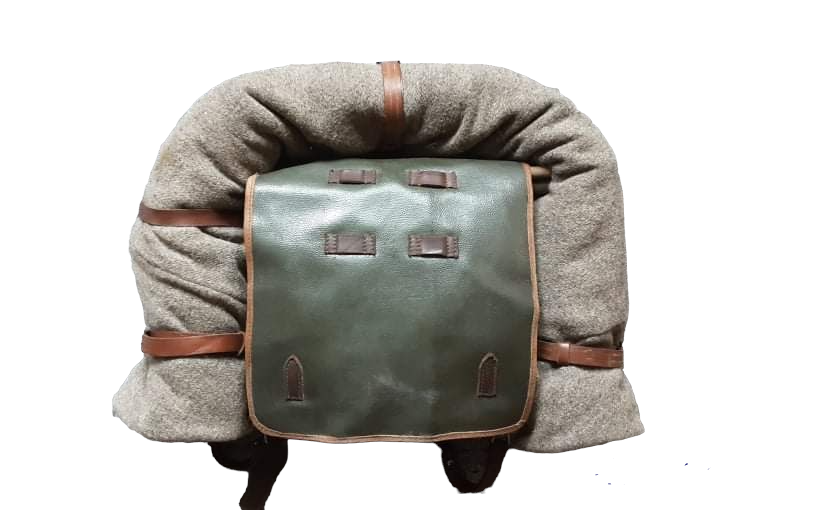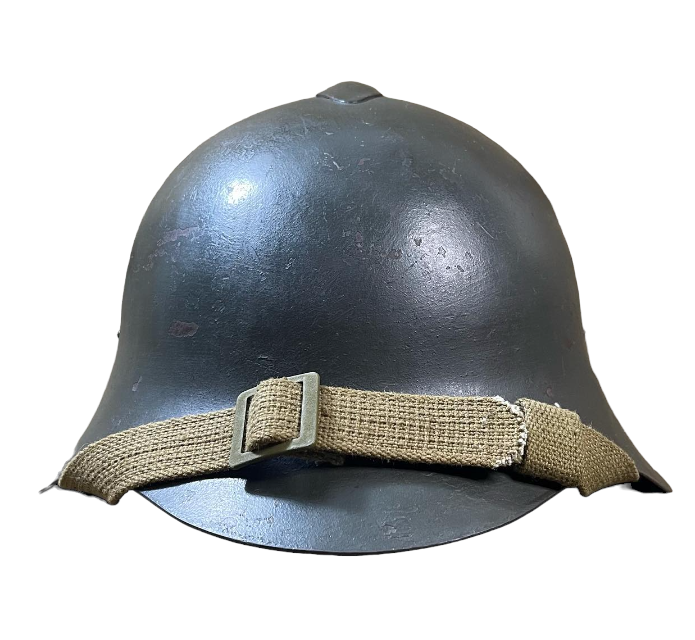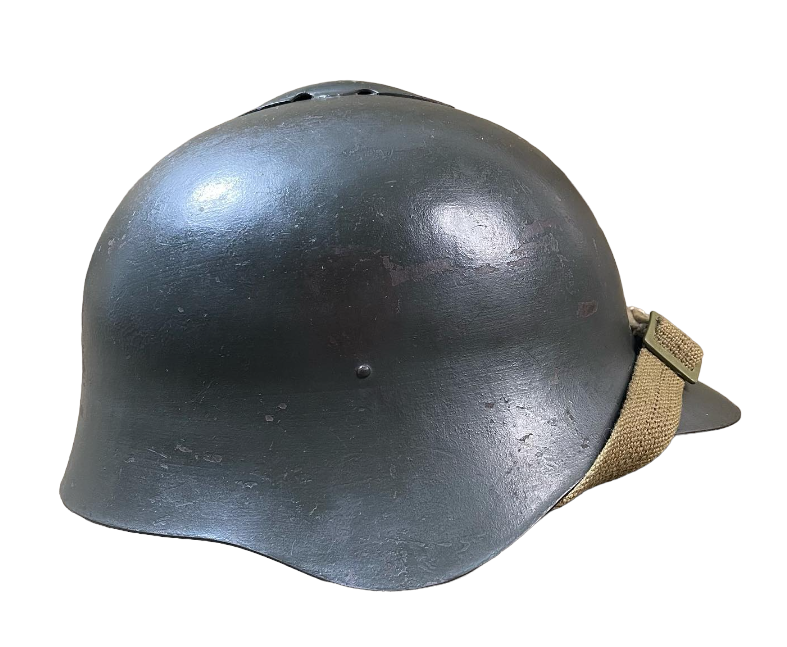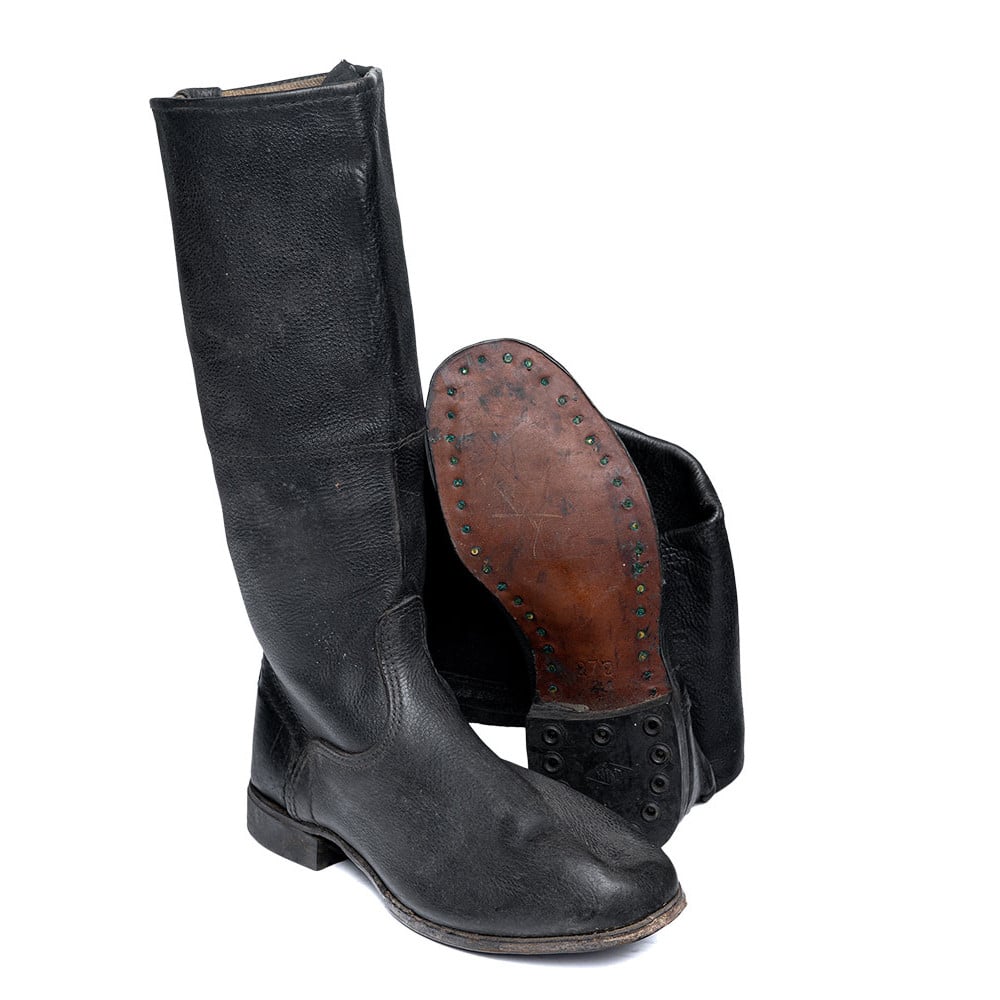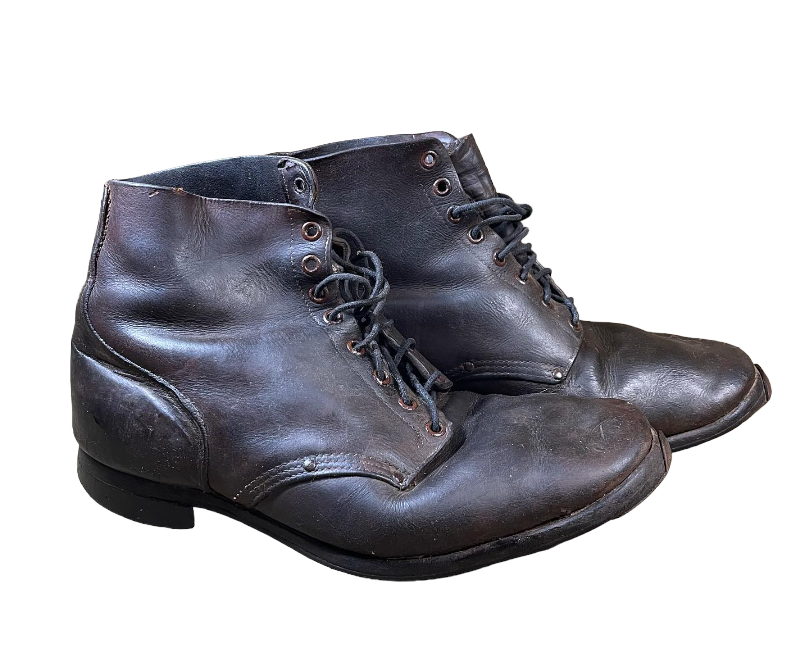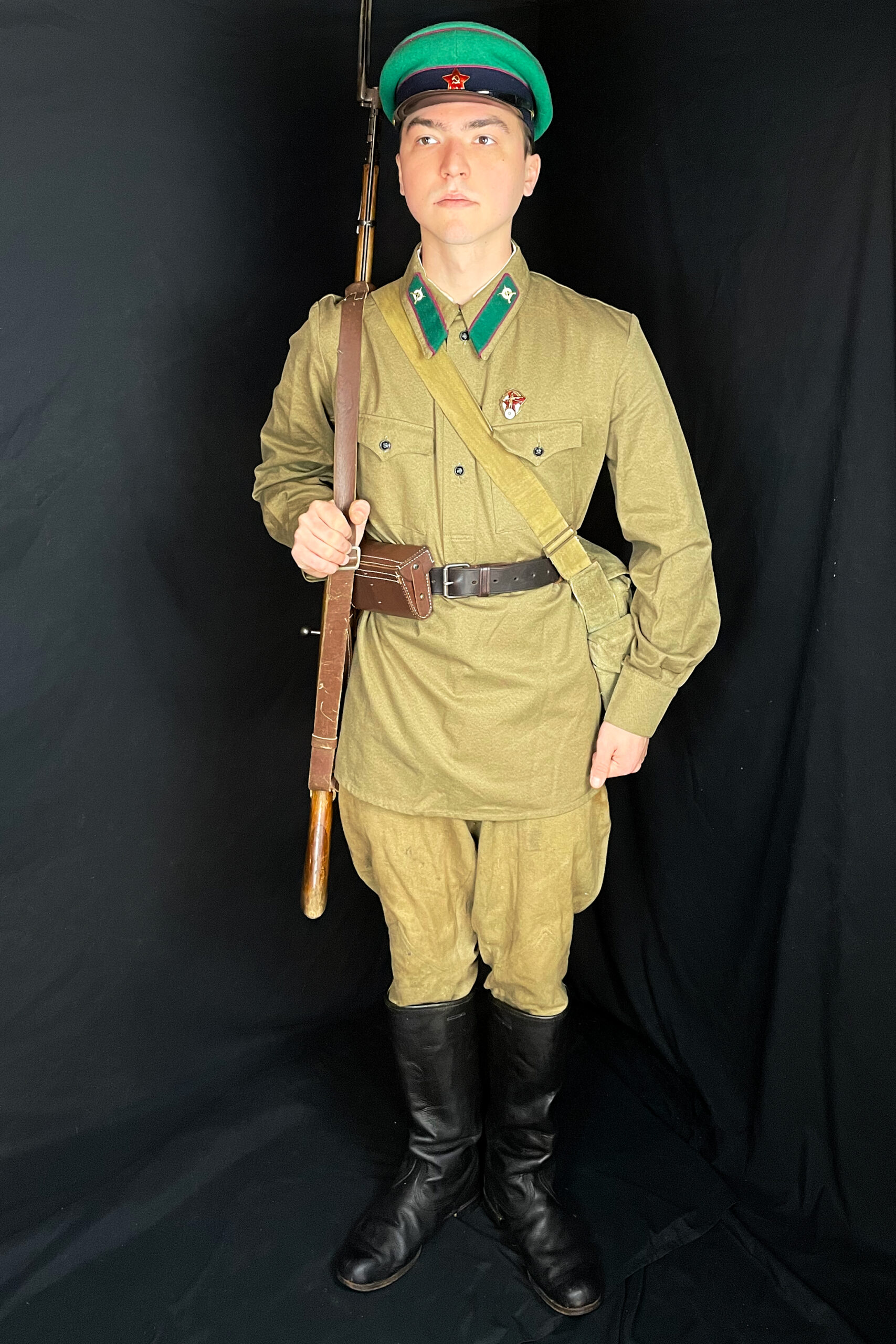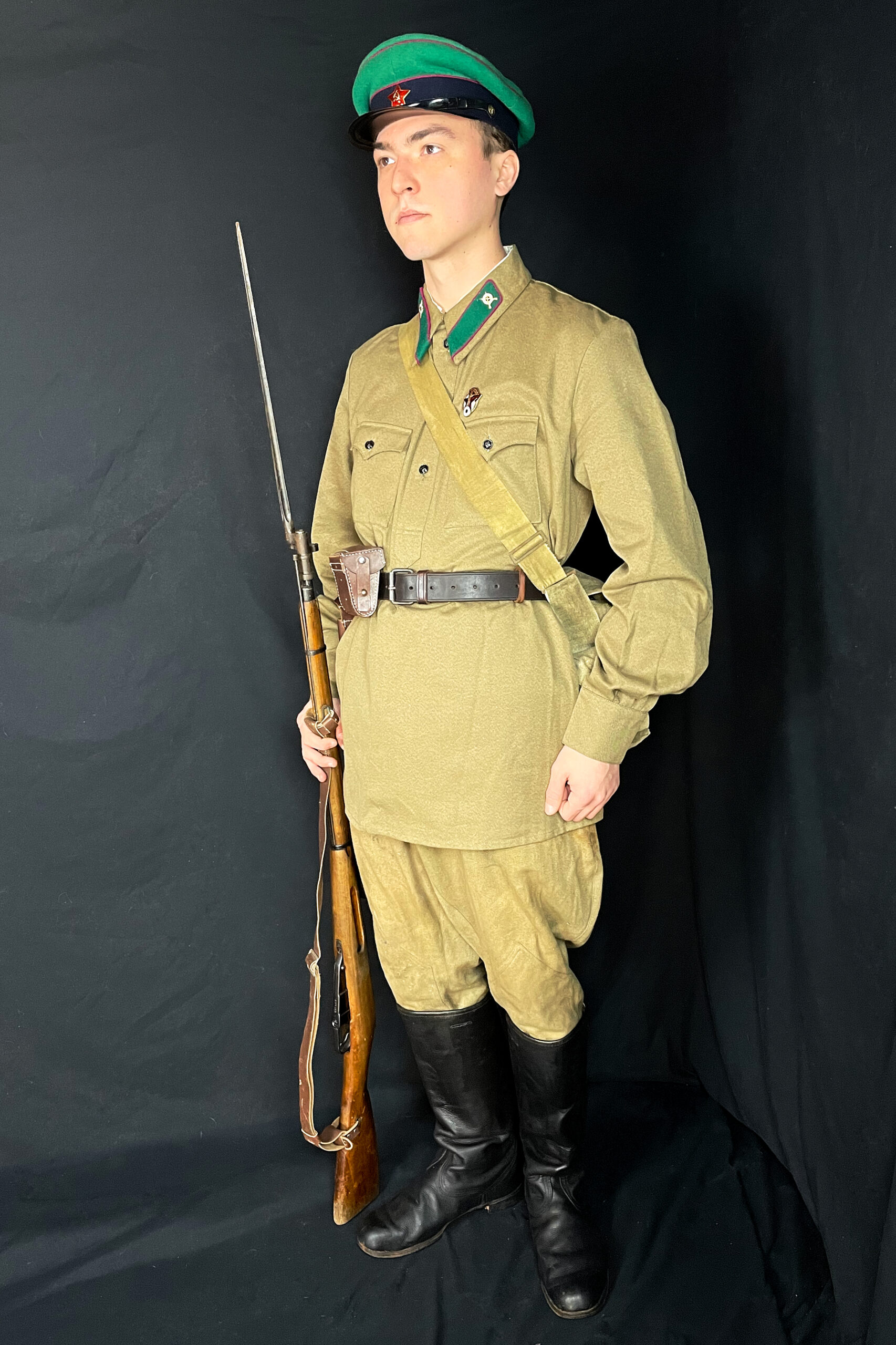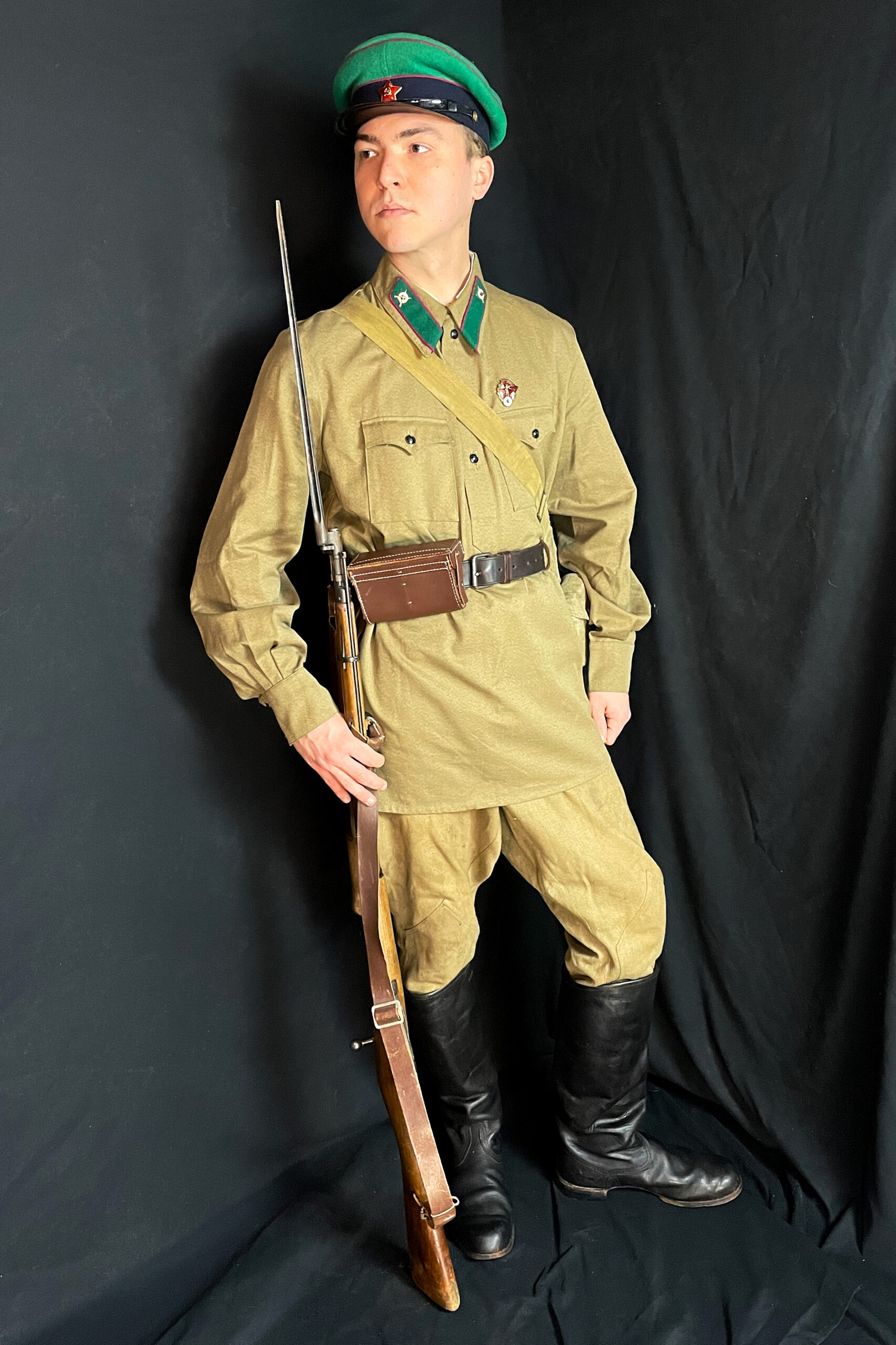Border Guards
By Andrusha Taras
The purpose of this article is a brief summary of the structure of NKVD Border Guard (PV) troops, their immediate tasks before Operation Barbarossa, as well as a guide for a faithful reconstruction of how NKVD Border Troops would have been uniformed and equipped just prior to the “Crisis Period” of 1941. The focus will be on enlisted infantry and officers within the PV along the Western Border only. Other branches of the NKVD (Security Troops, PV cavalry and air branches) have their own unique histories and material culture which will not be covered in this article.
Structure & Organization
Organized under the People’s Commissariat for Internal Affairs, or NKVD, the Border Troops of the Soviet Union bore the first wave of attacks in Operation Barbarossa, and represented Soviet power to any civilians living within or crossing the border region. Tasked with patrolling and regulating the borders of the Soviet Union, as well as assisting the Red Army with various security details and counterespionage, Frontier Divisions of the NKVD were the first obstacle which German forces had to overcome on 22 June 1941. As of 1 June of that year, 167,582 total personnel were on the rosters of the various Border Guard units throughout the entire USSR. The vast majority of these soldiers were posted on the Western Border Districts; 127,300 men, or about 76% of total Border Guard forces. These troops were mostly “lightly armed security troops manning border guards posts in close cooperation with fortified regions the Red Army deployed along the Soviet frontier” (Glantz, Colossus Reborn, 159).
Organized under the People’s Commissariat for Internal Affairs, or NKVD, the Border Troops of the Soviet Union bore the first wave of attacks in Operation Barbarossa, and represented Soviet power to any civilians living within or crossing the border region. Tasked with patrolling and regulating the borders of the Soviet Union, as well as assisting the Red Army with various security details and counterespionage, Frontier Divisions of the NKVD were the first obstacle which German forces had to overcome on 22 June 1941.
As of 1 June of that year, 167,582 total personnel were on the rosters of the various Border Guard units throughout the entire USSR. The vast majority of these soldiers were posted on the Western Border Districts; 127,300 men, or about 76% of total Border Guard forces. These troops were mostly “lightly armed security troops manning border guards posts in close cooperation with fortified regions the Red Army deployed along the Soviet frontier” (Glantz, Colossus Reborn, 159).
Organized under the People’s Commissariat for Internal Affairs, or NKVD, the Border Troops of the Soviet Union bore the first wave of attacks in Operation Barbarossa, and represented Soviet power to any civilians living within or crossing the border region. Tasked with patrolling and regulating the borders of the Soviet Union, as well as assisting the Red Army with various security details and counterespionage, Frontier Divisions of the NKVD were the first obstacle which German forces had to overcome on 22 June 1941. As of 1 June of that year, 167,582 total personnel were on the rosters of the various Border Guard units throughout the entire USSR. The vast majority of these soldiers were posted on the Western Border Districts; 127,300 men, or about 76% of total Border Guard forces. These troops were mostly “lightly armed security troops manning border guards posts in close cooperation with fortified regions the Red Army deployed along the Soviet frontier” (Glantz, Colossus Reborn, 159).
In the whole NKVD PV apparatus, the entire Soviet Union was divided into 17 border districts, including 96 ground detachments and 18 separate border commands. These forces, overall, also encompassed fighter aviation regiments and squadrons, naval detachments, communications and engineering troops, and NCO training schools. Covering the Western Border of the USSR included eight border districts, with 47 ground detachments and nine separate border command posts. The Western Border Districts were also augmented with 11 regiments of NKVD Operational Forces, in addition to Red Army forces. The PV units immediately along the Western border frequently maintained “operational reaction outposts” or special maneuver groups to protect the border regions, with each outpost fielding at least 42 men. These reaction outposts would work in tandem with checkpoints, observation posts, and regular patrols in order to keep the border zone secure. On average, a single border command in June 1941 would oversee 2,265 men each, with others numbering as many as 3,000 per command (Glantz, Colossus Reborn, 160). While vehicles were available, these forces would typically rely on horses for faster transportation, and utilized dogs while on patrol both as a tracking method and security measure when necessary.
According to David Glantz, each PV detachment along the Western Border “consisted of four or five komendaturas [комендантская служба, Commandant’s Service]. The komendatura contained four line border outposts (zastav), three with 42 to 64 men and a reserve outpost of 42 men, a maneuver group of three to five outposts with 50 men each, and an NCO school with 70-100 men” (Glantz, Stumbling Colossus, 174). A 1946 “Handbook on USSR Military Forces” manual has a useful diagram of how these various commands would be deployed along a border zone, with each komendatura patrolling approximately 20 miles / 32 kilometers of territory along the border.
In the whole NKVD PV apparatus, the entire Soviet Union was divided into 17 border districts, including 96 ground detachments and 18 separate border commands. These forces, overall, also encompassed fighter aviation regiments and squadrons, naval detachments, communications and engineering troops, and NCO training schools. Covering the Western Border of the USSR included eight border districts, with 47 ground detachments and nine separate border command posts. The Western Border Districts were also augmented with 11 regiments of NKVD Operational Forces, in addition to Red Army forces.
The PV units immediately along the Western border frequently maintained “operational reaction outposts” or special maneuver groups to protect the border regions, with each outpost fielding at least 42 men. These reaction outposts would work in tandem with checkpoints, observation posts, and regular patrols in order to keep the border zone secure. On average, a single border command in June 1941 would oversee 2,265 men each, with others numbering as many as 3,000 per command (Glantz, Colossus Reborn, 160). While vehicles were available, these forces would typically rely on horses for faster transportation, and utilized dogs while on patrol both as a tracking method and security measure when necessary.
According to David Glantz, each PV detachment along the Western Border “consisted of four or five komendaturas [комендантская служба, Commandant’s Service]. The komendatura contained four line border outposts (zastav), three with 42 to 64 men and a reserve outpost of 42 men, a maneuver group of three to five outposts with 50 men each, and an NCO school with 70-100 men” (Glantz, Stumbling Colossus, 174). A 1946 “Handbook on USSR Military Forces” manual has a useful diagram of how these various commands would be deployed along a border zone, with each komendatura patrolling approximately 20 miles / 32 kilometers of territory along the border.
In the whole NKVD PV apparatus, the entire Soviet Union was divided into 17 border districts, including 96 ground detachments and 18 separate border commands. These forces, overall, also encompassed fighter aviation regiments and squadrons, naval detachments, communications and engineering troops, and NCO training schools. Covering the Western Border of the USSR included eight border districts, with 47 ground detachments and nine separate border command posts. The Western Border Districts were also augmented with 11 regiments of NKVD Operational Forces, in addition to Red Army forces. The PV units immediately along the Western border frequently maintained “operational reaction outposts” or special maneuver groups to protect the border regions, with each outpost fielding at least 42 men. These reaction outposts would work in tandem with checkpoints, observation posts, and regular patrols in order to keep the border zone secure. On average, a single border command in June 1941 would oversee 2,265 men each, with others numbering as many as 3,000 per command (Glantz, Colossus Reborn, 160). While vehicles were available, these forces would typically rely on horses for faster transportation, and utilized dogs while on patrol both as a tracking method and security measure when necessary.
According to David Glantz, each PV detachment along the Western Border “consisted of four or five komendaturas [комендантская служба, Commandant’s Service]. The komendatura contained four line border outposts (zastav), three with 42 to 64 men and a reserve outpost of 42 men, a maneuver group of three to five outposts with 50 men each, and an NCO school with 70-100 men” (Glantz, Stumbling Colossus, 174). A 1946 “Handbook on USSR Military Forces” manual has a useful diagram of how these various commands would be deployed along a border zone, with each komendatura patrolling approximately 20 miles / 32 kilometers of territory along the border.
Primary Responsibilities
These troops were not to be deployed in sustained, heavy combat. Border Guards were as a general rule rather lightly armed, although some tank and artillery units were provided in areas of high risk or where other reinforcements were unavailable, such as the Far East or South-Central Asia. The primary objectives of the PV was to “patrol the border, detain line-crossers, counter enemy reconnaissance and diversionary action, and serve as a tripwire for regular forces” (Glantz, Stumbling Colossus, 174). While the Soviet Union had always theoretically prepared for offensive operations, the PV would serve as a delaying force in the case of invasion – a “tripwire”. At that point, the Red Army would take over defensive operations and PV troops would be relieved to pull rear security. In reality, many of the border detachments would be almost entirely destroyed, with many being killed, captured, or joining the partisan movement. Border troops which escaped disaster could expect to either assist the Red Army with rear security, or be formally reformed into NKVD Rifle Regiments with many of the same combat duties as Red Army soldiers.
Because of this expected activity, the border outposts were generally armed with standard infantry weapons. These included the Mosin 91/30 rifles and M38 carbines, SVT38/40 rifles, PPD-40 submachine guns, Maxim machine guns, 50mm mortars, and dogs. Officers would be armed with the standard TT-33 or Nagant revolver. As the NKVD enjoyed priority status, these troops were generally well equipped for the primary duties of patrolling and interception along border regions.
These troops were not to be deployed in sustained, heavy combat. Border Guards were as a general rule rather lightly armed, although some tank and artillery units were provided in areas of high risk or where other reinforcements were unavailable, such as the Far East or South-Central Asia. The primary objectives of the PV was to “patrol the border, detain line-crossers, counter enemy reconnaissance and diversionary action, and serve as a tripwire for regular forces” (Glantz, Stumbling Colossus, 174). While the Soviet Union had always theoretically prepared for offensive operations, the PV would serve as a delaying force in the case of invasion – a “tripwire”. At that point, the Red Army would take over defensive operations and PV troops would be relieved to pull rear security. In reality, many of the border detachments would be almost entirely destroyed, with many being killed, captured, or joining the partisan movement. Border troops which escaped disaster could expect to either assist the Red Army with rear security, or be formally reformed into NKVD Rifle Regiments with many of the same combat duties as Red Army soldiers.
Because of this expected activity, the border outposts were generally armed with standard infantry weapons. These included the Mosin 91/30 rifles and M38 carbines, SVT38/40 rifles, PPD-40 submachine guns, Maxim machine guns, 50mm mortars, and dogs. Officers would be armed with the standard TT-33 or Nagant revolver. As the NKVD enjoyed priority status, these troops were generally well equipped for the primary duties of patrolling and interception along border regions.
Enlisted Uniforms & Equipment
Soldiers and officers of the Border Troops were uniformed very similarly to their Red Army counterparts, with a few distinguishing features to identify them not only as NKVD troops, but specifically as border guards. The jackboots, footwraps, underwear and trousers of PV enlisted men were identical to their Red Army counterparts. From the photographic evidence available, it appears that Border Guard troops also received priority on proper jackboots (сапоги, sapogi) rather than the economy low boots and puttees. Feel free to see our guide on a 1941 Red Army impression here!
The most notable and identifying mark of the Frontier Divisions was the unique headwear. Although pilotkas do show up here and there in pictures, typically in the wartime years, the standard hat for the majority of the PV was a visor cap (Фуражка, Furazhka). All ranks, enlisted to high officers, wore this bright green woolen cap, featuring a dark blue band and magenta or crimson piping, adorned with an enamel star common on Soviet military headwear. The 1935 pattern caps, standard by 1941, featured a squared-off visor made of fiberboard with standard 32mm enamel stars in the center. These visor caps also utilized a metal wire on the inside of the cap, in order to keep the general shape – a feature that differs from visor caps of the 1920s, the tops of which tended to slightly sag with wear.
Tunics of the NKVD were also a slightly different pattern than the standard Red Army models, featuring exposed buttons on the placket, but otherwise very similar. These 1938 pattern tunics had black anodized metal buttons for enlisted personnel, external chest pockets, and elbow reinforcements. The NKVD Border Troops utilized a collar tab insignia which matched their distinctive caps, featuring a green field bordered by crimson piping. Tunics on the NKVD PV also were expected to have collar liners sewn daily. For the purposes of reenacting, the rank system of the NKVD frontier troops are identical in style and type to the Red Army in the pre-war era, with the additional title “of State Security” to the end of ranks; ie a “Junior Platoon Commander of State Security” with the 1935-40 rank systems, or “Senior Sergeant of State Security” with the 1940-41 rank systems. Refer to our rank insignia guide here! Unlike soldiers of the RKKA, branches of service pins seem to be more universal and common within the ranks of the PV, with enlisted personnel seen in pictures with respective branches of service pins, including engineers, signals, and infantry pins being seen. Among enlisted ranks, various civilian awards can be seen, including Komsomol, Voroshilov, and many Osoaviakhim badges on tunics.
Tunics of the NKVD were also a slightly different pattern than the standard Red Army models, featuring exposed buttons on the placket, but otherwise very similar. These 1938 pattern tunics had black anodized metal buttons for enlisted personnel, external chest pockets, and elbow reinforcements. The NKVD Border Troops utilized a collar tab insignia which matched their distinctive caps, featuring a green field bordered by crimson piping. Tunics on the NKVD PV also were expected to have collar liners sewn daily. For the purposes of reenacting, the rank system of the NKVD frontier troops are identical in style and type to the Red Army in the pre-war era, with the additional title “of State Security” to the end of ranks; ie a “Junior Platoon Commander of State Security” with the 1935-40 rank systems, or “Senior Sergeant of State Security” with the 1940-41 rank systems.
Refer to our rank insignia guide here! Unlike soldiers of the RKKA, branches of service pins seem to be more universal and common within the ranks of the PV, with enlisted personnel seen in pictures with respective branches of service pins, including engineers, signals, and infantry pins being seen. Among enlisted ranks, various civilian awards can be seen, including Komsomol, Voroshilov, and many Osoaviakhim badges on tunics.
Tunics of the NKVD were also a slightly different pattern than the standard Red Army models, featuring exposed buttons on the placket, but otherwise very similar. These 1938 pattern tunics had black anodized metal buttons for enlisted personnel, external chest pockets, and elbow reinforcements. The NKVD Border Troops utilized a collar tab insignia which matched their distinctive caps, featuring a green field bordered by crimson piping. Tunics on the NKVD PV also were expected to have collar liners sewn daily. For the purposes of reenacting, the rank system of the NKVD frontier troops are identical in style and type to the Red Army in the pre-war era, with the additional title “of State Security” to the end of ranks; ie a “Junior Platoon Commander of State Security” with the 1935-40 rank systems, or “Senior Sergeant of State Security” with the 1940-41 rank systems. Refer to our rank insignia guide here! Unlike soldiers of the RKKA, branches of service pins seem to be more universal and common within the ranks of the PV, with enlisted personnel seen in pictures with respective branches of service pins, including engineers, signals, and infantry pins being seen. Among enlisted ranks, various civilian awards can be seen, including Komsomol, Voroshilov, and many Osoaviakhim badges on tunics.
Overcoats were universal and year-round items in the NKVD PV, with some pictures of surrendering border guards also show Obr.35 “Technical” coats being worn during Barbarossa – likely an item kept for patrols where the added mobility of a shorter jacket would be beneficial. Oddly enough, the photo showing a Obr.35 “technical” jacket also seems to show it without the collar tabs attached, unlike photos of the greatcoats. In wintertime, the green visor caps can be seen replaced with “budenovka” type hats, with pattern 1927/31 and 1935 variants being seen. These caps would have the light green star of the PV sewn onto the front, and feature a 35mm enamel star. Check out the article on these “winter helmets” here!
One unique aspect of the Frontier Divisions was the use of camouflage oversuits. According to various photographs, we can see the most common type of camouflage was the one-piece “Amoeba” oversuit, being worn while on patrol. Schusters makes a reproduction of this one-piece variant.
Border formations were lightly armed, and similarly equipped with the bare necessities for the tasks of patrolling border zones. Looking at original photographs, we can see universally common elements such as leather belts, 1937 pattern ammunition pouches, canteens, and gas mask bags. These ammunition pouches can either be the older “Tsarist” style box-type pouches, or the more modern two-cell pouches. Depending on time and region, sometimes two ammunition pouches are seen, though one pouch is more prevalent. Occasional bandoliers and RGD-33 grenade pouches are spotted both in film and on the field. Soldiers armed with the SVT are seen with its accompanying magazine pouch and bayonet. It is notable that NKVD frontier guards are seen without the small infantry shovel and carrier, standard to the Red Army, as it was likely deemed not necessary. Gas mask bags could be of the Obr.28 or Obr.36 type, and would most likely contain all of the required anti-gas equipment. The use of field glasses, or binoculars, was common to assist with patrol duties.
Commanders’ Uniforms & Equipment
As mentioned above, enlisted personnel and officers below general within the NKVD PV wore the same visor cap, made of green wool with a fiberboard visor and 35mm enamel star attached.
Officer tunics of the NKVD were visibly different from the enlisted patterns by a couple of features. Most notably, officer buttons were polished brass rather than the anodized buttons of the enlisted. Similar to officer tunics of the Red Army, NKVD officer tunics also featured piping along the collar and upper cuffs, with sleeve chevrons corresponding to the rank of the individual. As in the Red Army, political workers wore a red star patch in place of these sleeve chevrons. The chest pockets on officer tunics were pleated as well, versus the flat pockets seen on enlisted tunics. In addition, officer tunics lacked elbow reinforcements. These tunics could be made from either cotton or wool, and would feature collar insignia of a green background trimmed with gold.
Trousers were also made of either cotton or blue wool, lacking knee reinforcements for officers and trimmed with the branch of service. Officers can be seen in summer months wearing the dark blue woolen trousers, attesting to their popularity within the command ranks.
Officer overcoats are the same pattern of Red Army officers, featuring a double breasted front closed with brass buttons, versus the hidden “hook-and-eyes” of the enlisted overcoats. These overcoats would feature the accompanying rank collar tabs, laced with gold.
As mentioned above, enlisted personnel and officers below general within the NKVD PV wore the same visor cap, made of green wool with a fiberboard visor and 35mm enamel star attached.
Officer tunics of the NKVD were visibly different from the enlisted patterns by a couple of features. Most notably, officer buttons were polished brass rather than the anodized buttons of the enlisted. Similar to officer tunics of the Red Army, NKVD officer tunics also featured piping along the collar and upper cuffs, with sleeve chevrons corresponding to the rank of the individual. As in the Red Army, political workers wore a red star patch in place of these sleeve chevrons. The chest pockets on officer tunics were pleated as well, versus the flat pockets seen on enlisted tunics. In addition, officer tunics lacked elbow reinforcements. These tunics could be made from either cotton or wool, and would feature collar insignia of a green background trimmed with gold.
Trousers were also made of either cotton or blue wool, lacking knee reinforcements for officers and trimmed with the branch of service. Officers can be seen in summer months wearing the dark blue woolen trousers, attesting to their popularity within the command ranks.
Officer overcoats are the same pattern of Red Army officers, featuring a double breasted front closed with brass buttons, versus the hidden “hook-and-eyes” of the enlisted overcoats. These overcoats would feature the accompanying rank collar tabs, laced with gold.
Both 1932 and 1935 style belts can be seen in the PV, with the single “cross” strap seeming more dominant than the two strap “braces” style in pictures. However, both styles of belts and both styles of cross straps do appear. On these belts would be holsters for the TT33 or Nagant pistols, with mapcases and binocular cases being common accessories. The common theme between officer and enlisted gear is that whatever is not immediately needed for the patrolling and intervention duties was omitted. Some officers even appear in images without map cases entirely.
We hope this written guide, accompanied by various original photographs, helps living historians assemble a faithful reconstruction of the Frontier Divisions. These soldiers were unique not just for their distinctive uniform, but for the stories of dedication and heroism which emerged from the Barbarossa period – most famously at Brest Fortress – and also in forming a base of experienced soldiers within the partisan movement as the Red Army retreated. Both Voin and Schusters offer reproductions of the various tunics, headwear, and insignia utilized by the NKVD Frontier Divisions.
Both 1932 and 1935 style belts can be seen in the PV, with the single “cross” strap seeming more dominant than the two strap “braces” style in pictures. However, both styles of belts and both styles of cross straps do appear. On these belts would be holsters for the TT33 or Nagant pistols, with mapcases and binocular cases being common accessories. The common theme between officer and enlisted gear is that whatever is not immediately needed for the patrolling and intervention duties was omitted. Some officers even appear in images without map cases entirely.
We hope this written guide, accompanied by various original photographs, helps living historians assemble a faithful reconstruction of the Frontier Divisions. These soldiers were unique not just for their distinctive uniform, but for the stories of dedication and heroism which emerged from the Barbarossa period – most famously at Brest Fortress – and also in forming a base of experienced soldiers within the partisan movement as the Red Army retreated. Both Voin and Schusters offer reproductions of the various tunics, headwear, and insignia utilized by the NKVD Frontier Divisions.
Clothing And Insignia
Model 1938 Gymnastyorka
A tricot pullover cotton tunic, with stand and fall collar and front buttons without a fly front. Two pockets on the front. Also has elbow reinforcements. A white strip of cotton, usually 3-5 cm wide, is sewn into the collar of the uniform to protect it from sweat. You need a collar liner in your tunic. Voin, and Schuster make excellent tunics, Voin also makes excellent border guard insignia.
Model 1937 Gymnastyorka (Optional)
Commonly referred to as the “summer” border guards tunic was worn without a collar liner, and commonly seen in the far east, and other areas of the USSR with much a hotter and humid climate. This model of tunic is optional and should only be used for those who are looking to do a far east border guards impression, not for western border guards. Voin make this model of tunic, as well as the insignia.
Underclothes
White cotton undershirts with either a rounded collar or a buttoned “V” collar as well as long white underpants were standard issue. Each soldier carried two sets. Winter weight underclothes were a heavier weight of cotton. Voin makes all variations of the shirt and pants, and Cold War sets are still available. They are largely identical.
Model 1935 Furashka
The cap consists of an oval-shaped circle (bottom), four equal-sized arched quarters, a straight solid band, a visor and a strap. The front of the cap is made almost straight, with slightly convex quarters on a semi-rigid stand. The colors for border guards is a dark blue body with a green top and raspberry piping. The furashka must have a 37mm red enamel cap star. Voin, Leningrad Hat Maker, and Schusters make reproductions of the border guards furashka.
Model 1935 Panama (Optional)
This style of hat was issues out to border guards and Red Army soldiers stationed out in the far east and areas with higher temperatures and a hotter climate. This model of hat should only be used for a far east border guards impression, only to be worn with the model 1937 “summer” tunic. This is NOT meant to be interchangeable with the furashka. A red enamel cap star is recommended, but not required. Voin and Leningrad Hat Maker makes an excellent reproduction of the panama style hat.
Greatcoat
A woolen, double breasted coat, closed by hooks and eyes. On the collar, you should have Model 1941 insignia, or no insignia at all. Models appropriate for 1942 include the Model 1932, 1938, and 1941. Color should range from greyish white to steel gray to light brown. Try to avoid model 1969 “Brezhnev” coats. Voin and Schusters offer solid reproductions.
Model 1932 Amoeba Camo (Optional)
Either the one piece or two piece ameoba camo suit is acceptable for a border guards impression. This is entirely optional as not every border guard was issued this piece of kit, but there are many instances of them being used by border guards in the field. Voin and Schusters make reproductions of this model of camouflage suit.
Equipment
Model 1937 Rifle Pouches
One, sometimes two leather pouch for Mosin or SVT ammo was usually carried at this point in the war, on the front right of the belt. The Model 1937 pouch had many variations of its closure strap, but the basic design of a two celled box with a ring on the back remained constant. The Tsarist model 1909 pouch is also acceptable. Do not use Kirza ammo pouches. RGM is the premier maker of reproductions, but for a cheaper option early East German examples can be used if properly darkened. RGM, Voin, and Schusters all make a variety of rifle pouches.
PPD-40 Drum Pouch
With the increased issue of the PPD-40 and eventually the new PPSh-41 submachine gun, a cloth pouch for the drum magazine was issued and worn in the same spot as the rifle pouch. In some cases for pre and early war 2 pouches were issued but it just as common to be issued only one pouch. Soldiers generally had two drums for the gun, one kept in the pouch, and one in the gun. Voin makes excellent reproduction pouches, and RGM occasionally has original drum pouches for sale.
Canteen and Carrier
The Model 1932 canteen, with a screwtop is the standard to be used. Glass canteens are also acceptable to use. East German reparations canteens are the closest non original item. Postwar canteens are acceptable if one has removed the paint, but try to avoid them if possible. It should be contained in a Model 1941 carrier, a cotton bag with a closure that goes over the top of the bottle. Leningrad Restoration Workshop restores and sells original Soviet canteens.
Mess Kit
The existing stocks of the Model 1936 mess kit and older Model 1927 aluminum pots would be issued. Soldiers also carried a mug and spoon, and since they usually brought their own when they were mobilized, there is no standard model. Avoid modern graniteware cups, with their telltale exposed metal rim at the top. Leningrad Restoration Workshop restores and sells original Soviet mess kits.
Gasmask and Bag
For border guards, the model 1936 would have been the most common in 1940 and 1941. The model 1940 are also acceptable for an early war border guard impression. The main mask of the Red Army during this period was the ShM-1, connected with a cloth covered hose to a MT-4 filter. The MT-4 is a flatish box filter, painted green and with ribs for reinforcement. You can use the mask bag as storage for items, as Red Army men did. Voin, Schusters, and RGM makes excellent Model 1936 bags.
Backpack - Obr. 36 Ranets (Optional)
A German style tornister square framed bag, with loops around it for the attachment of a mess kit and a greatcoat. Fantastically stylish yet impractical, these packs were on the way out in 1941. They are still seen rarely into 1942, however. Voin and Ivan Alekseev repro them. This is an optional piece of kit to use for a border guard impression, but for 1940 and 1941 this would have been on of the main packs seen used by soldiers. A model 1939 pack or a meshok is also acceptable to use for a border guards impression, but the pack isn’t as important as some of the other pieces of equipment.
Helmet
SSH-36
Introduced in 1936, this model of helmet is iconic for it’s prewar use and blend of design influences. For 1941, the helm can have a star on the front or be left blank. Originals are out there, but IMA and World War Supply make reproductions, with the WWS model being higher quality but only made in a smaller size (55-58cm head, although you can modify the liner to fit a 59). This helmet was seen into early 1942, but fades from use by the late summer.
SSH-36
Introduced in 1936, this model of helmet is iconic for it’s prewar use and blend of design influences. For 1941, the helm can have a star on the front or be left blank. Originals are out there, but IMA and World War Supply make reproductions, with the WWS model being higher quality but only made in a smaller size (55-58cm head, although you can modify the liner to fit a 59). This helmet was seen into early 1942, but fades from use by the late summer.
Footwear
Jackboots
All leather boot, with a shaft rising up to above the calf. The soles should be leather as well, with no hobnails, but toe and heel irons have been noticed. The shape of the shaft should be more stovepipe-like, rather than the oblong German style shafts. This is a hard piece of gear to get, as postwar examples that are correct have largely dried up, especially in bigger sizes. There was reproductions made, but they seem to have been all sold and are only encountered on the secondary market.
Low Boots and Puttees
In a economizing measure, low boots and puttees were reintroduced to the Red Army by 1938. These boots were very similar to German models, with 8 to 9 eyelet rows and a curved vamp. Soviet boots however were made from smooth side out leather. These were always worn with puttees, for border guards, only black puttees should be born. As with jackboots, this is a hard piece of kit to get, with repros and postwar usable examples disappearing from the market. Voenspec and Schusters make the black puttees.
Impression Photos
-click to expand each photo-

